VF-33
| Fighter Squadron 33 | |
|---|---|
.jpg) VF-33 insignia | |
| Active |
6 August 1942 - 19 November 1945 12 October 1948 - 1 October 1993 |
| Country | United States |
| Branch | USN |
| Type | Fighter |
| Nickname |
Hellcats (1943-1945) Tarsiers (1948-1958, 1961-1981) Astronauts (1958-1961) Starfighters (1981-1993) |
| Aircraft flown | |
| Fighter |
F6F-3/-5 Hellcat, F4U-4 Corsair F9F-6 Cougar FJ-3/-3M Fury F11F-1 Tiger F-8B/E Crusader F-4B/J Phantom II F-14A Tomcat |
Fighter Squadron 33 (VF-33) was an aviation unit of the United States Navy. The first VF-33 was originally commissioned in 6 August 1942 and disestablished on 19 November 1945. A second VF-33 was then reactivated on 11 October 1948. With the reduction of forces after the end of the Cold War, this squadron was disestablished on 1 October 1993.
VF-33 History
World War II
The first fighter squadron ("FitRon" in USN parlance[1]) to be designated as Fighter Squadron 33 (VF-33) was originally established as VGS-16 on 6 August 1942 and then redesignated as VC-16 on 1 March 1943. VC-16 was redesignated VF-33 on 15 August 1943 and equipped with the Grumman F6F Hellcat making their combat debut in the Solomon Islands. VF-33 was the first US Navy unit to use the F6F in the Solomon Islands campaign, being joined soon after by VF-38 and VF-40.
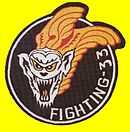
VF-33 was land based at this time, supporting the island-hopping Pacific War campaign. By the end of 1943 VF-33 was credited with 60 Japanese aircraft shot down, and had produced three aces (five or more kills); Lt.(jg) Frank E. Schnieder with seven kills, Lt. C. K. Hildebrandt with five kills, and Lt.(jg) James J. Kinsella also with five kills, three on VF-33, two flying F4F-4s with VF-72.[2][3] During the Second World War VF-33's patch was a black "Hellcat" leaping out of red flames on a white circle outlined in red; the motto "The Hellcats" was written in black script.[4] After the war, VF-33 was disestablished on 19 November 1945.
Korean War
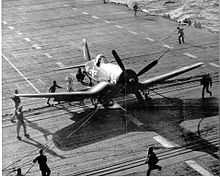
A second Fighter Squadron 33 was established on 11 October 1948 and equipped with the Chance-Vought F4U-4 Corsair. It was assigned to Carrier Air Group Three (CVG-3) and made two deployments on the aircraft carrier USS Leyte (CV-32). The first was to the Mediterranean Sea in mid-1950 quickly followed by a combat deployment to Korea from September 1950 to February 1951. For its action in the Korean war VF-33 earned the Navy Unit Citation. The squadron called themselves the "Tarsiers", which was a fierce monkey. The squadron affectionately called their Tarsier "Minky".
Jet transition
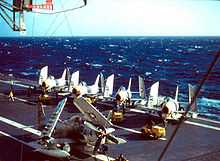
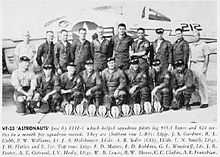

Following its deployment to Korea VF-33 returned to the U.S. East Coast and transitioned to the Grumman F9F-6 Cougar. The squadron was assigned to Carrier Air Group Six (CVG-6) and deployed to the Mediterranean Sea aboard the USS Midway (CVA-41) in 1954. After this tour the Tarsiers again transitioned to the North American FJ-3 Fury and made three deployments in 1956 and 1957 to the Atlantic Ocean and Mediterranean Sea, this time aboard the carriers USS Lake Champlain (CV-39), USS Leyte (CVS-32), and USS Intrepid (CVA-11). Aboard Intrepid VF-33 took part in the NATO exercise Operation Strikeback. As part of a series of exercises to simulate an all-out Soviet attack on NATO, Operation Strikeback was tasked with two objectives. Its initial objective was the deployment of NATO's naval forces (designated the "Blue Fleet") against other NATO forces attempting to simulate an "enemy" navy that featured a large number of submarines (designated the "Orange Fleet"). Its other objective was to have the Blue Fleet execute carrier-based air strikes against "enemy" formations and emplacements along NATO's northern flank in Norway. Operation Strikeback involved over 200 warships, 650 aircraft, and 75,000 personnel.
In 1958 VF-33 transitioned to the supersonic Grumman F11F-1 Tiger and was renamed Astronauts. As part of CVG-6 VF-33 made two tours to the Mediterranean Sea aboard the Intrepid.
In early 1961 the squadron changed already to its fourth jet fighter in seven years, the Vought F8U-1E Crusader, and changed its name back to Tarsiers. VF-33 took its F8U-1E (F-8B) again aboard Intrepid to the Med in 1961-62 and was then equipped with the F8U-2NE (F-8E) version. The squadron was then deployed aboard the first nuclear-powered aircraft carrier USS Enterprise (CVAN-65), to the Mediterranean Sea in August 1962. However, Enterprise was recalled in October to reinforce the naval blockade of Cuba during the Cuban Missile Crisis. In 1963 Enterprise and CVW-6 were again deployed to the United States Sixth Fleet, before taking part in Operation Sea Orbit in 1964. This was the around-the-world cruise of the United States Navy's Task Force One, consisting of USS Enterprise (CVAN-65), USS Long Beach (CGN-9), and USS Bainbridge (DLGN-25). This all-nuclear-powered unit steamed 56,606 km (30,565 nm) unrefuelled around the world for sixty-five days.
In 1964 the unit transitioned to the McDonnell F-4 Phantom II and would fly the Phantom for the next seventeen years alongside its sister squadron VF-102. The first VF-33 Phantom was the F-4B, which they flew until 1967 at which time they moved up to the F-4J which featured better radar, higher thrust engines, slatted tailplanes, extra fuel cells and a larger main wheels to handle the increased weight. Between 1965 and 1968 Carrier Air Wing Six made the shakedown cruise and three deployments aboard the USS America (CVA-66).
Vietnam operations
It would not take long until VF-33 deployed to combat in South-East Asia aboard USS America. During their time in the theatre VF-33 would drop over three million pounds of ordnance, flying 4000 combat hours over a period of 5 months. On July 10, 1968 VF-33 downed a MiG-21, the first air-to-air kill by an East Coast Fighter Squadron over North Vietnam.
Middle East crises
After their return, VF-33 was re-assigned to Carrier Air Wing Seven, and made eight deployments aboard the USS Independence (CVA-62) to the Mediterranean Sea between 1969 and 1981.

In September 1970 Independence, USS Saratoga (CVA-60), and USS John F. Kennedy (CVA-67) were deployed to the Middle East in case of any crisis evolving after the death of the Egyptian leader Gamal Abdel Nasser. A real crisis finally evolved in 1973 when Israel took heavy losses during the Yom Kippur War. To support Israel the U.S. initiated Operation Nickel Grass, which was a was an overt strategic airlift operation conducted by the United States to deliver weapons and supplies to Israel during the Yom Kippur War. The Military Airlift Command of the U.S. Air Force shipped 22,325 tons of tanks, artillery, ammunition, and supplies in C-141 Starlifter and C-5 Galaxy transport aircraft between 12 October and 14 November 1973. The USAF planes only flew over international waters and were escorted by U.S. Navy fighters over the Mediterranean, provided by CVW-1 (on John F. Kennedy), CVW-6 (on USS Franklin D. Roosevelt (CVA-42)) and CVW-7. The carriers operated about every 500 km, Independence operating as the eastern-most carrier off Crete. The carriers also served as refueling stops for Douglas A-4E Skyhawk fighters, which were taken from U.S. Navy stocks to replace the losses of the Israeli Air Force.[5]
VF-33 won several awards including the CNO Safety Award in 1969 and 1970 and during the 1975–1976 cruise they won the Golden Tailhook Award as the Navy recognised their skill at carrier landing. In February 1979 VF-33 had flown three years without accident. In early 1979 VF-33 also operated from the USS Dwight D. Eisenhower (CVN-69) during that carrier's shakedown cruise.
Tomcat transition
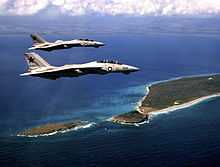
In 1981 VF-33 transitioned to the Grumman F-14A Tomcat along with VF-102 and joined Carrier Air Wing One assigned to USS America (CV-66). Until 1992 VF-33 made twelve deployments with CVW-1 aboard the America to the Atlantic Ocean, the Mediterranean Sea and the Indian Ocean. Their first deployment was a grueling North Atlantic NATO deployment (Northern Wedding) between August and October 1982. VF-33 has used stars as part of their tail markings since the Crusader days and settled on a large star for their latter F-4 tenure and as the main symbol on the Tomcat. In 1987, they abandoned "Minky" and changed their name from Tarsiers to Starfighters, which was their radio callsign. The new patch featured a large star with a head-on view of a Tomcat. On 20 August 1985 VF-33 was the first squadron to complete 50 missile firings without a single failure.
Gulf of Sidra operations
In March 1986 VF-33 would bring their F-14s into a combat environment for the first time on board USS America with Carrier Air Wing 1 as they took part in Operation Attain Document in the Mediterranean Sea alongside the Saratoga and USS Coral Sea (CV-43). VF-33 engaged two Libyan MiG-25s with intent on shooting down the F-14s, but the Tomcats outmaneuvered the Libyans and ended behind the Libyan fighters, but the pilots did not have permission to open fire. Along with VF-102 they provided air cover during the operation as the carrier group moved into the Gulf of Sidra, which was claimed by Libya to be the Line of Death. Libya claimed its territorial waters extended across the entire Gulf of Sidra as opposed to the internationally recognised limit of 12 miles, and because of this claim, any airplane or ship within these waters was in Libyan territory and liable to attack. US carriers occasionally challenged this assertion resulting in the first VF-41 Tomcat engagements with Libyan fighters in August 1981.
On 15 April 1986, after a terrorist attack on disco hall La Belle in Berlin, killing two American servicemen and a Turkish woman, President Ronald Reagan ordered airstrikes, called Operation El Dorado Canyon, against targets in Libya. F-111 bombers based at RAF Lakenheath and RAF Upper Heyford in the United Kingdom attacked targets in Tripoli while U.S. Navy A-6 Intruders from America and Coral Sea attacked targets in Benghazi. Navy and United States Marine Corps F/A-18 Hornets and Navy A-7’s attacked surface-to-air missile sites with AGM-88 HARM missiles. F-14 squadrons deployed in the Mediterranean, including VF-33, flew cover for the strike force. In 1986, VF-33 flew 895 continuous sorties without an abort.
In 1987 VF-33 made a short cruise on board the Navy’s newest carrier, the USS Theodore Roosevelt (CVN-71). After workups in 1988, VF-33 deployed on board America to the North Atlantic in February 1989, and again for a six-month Med-IO cruise from May through November. In February 1990 VF-33 made a two and a half month transit from San Diego to Philadelphia Naval Shipyard providing fighter protection as the carrier made the journey around the southern tip of South America. VF-33 took part in several joint exercises with South American nations during the transit.
Desert Storm operations

When Iraq invaded Kuwait in August 1990, four aircraft carriers were deployed to the region to provide carrier based air support for Operation Desert Shield. As the deadline for Iraqi withdrawal from Kuwait approached in January 1991, Theodore Roosevelt and America deployed to the region via the Suez Canal. VF-33 deployed with USS America arriving just as Operation Desert Storm commenced. America flew sorties alongside John F. Kennedy and Saratoga in the Red Sea before moving to the Persian Gulf to join USS Midway (CV-41), USS Ranger (CV-61) and Theodore Roosevelt. VF-33 and her sister squadron VF-102 were the only Tomcat squadrons to fly missions from both the Red Sea and Persian Gulf during Operation Desert Storm.
Disestablishment
In 1993 a VF-33 airframe became the first F-14 to log 5,000 flight hours. When the Navy decided to assign only a single TARPS Tomcat squadron per carrier air wing after the end of the Cold War, VF-33 was not TARPS capable and despite the squadron's success in Desert Storm, it was disestablished on 1 October 1993. However, the tradition of VF-33 lives on through a very active alumni group that hosts a website and periodic reunions.[6]
See also
- History of the United States Navy
- List of inactive United States Navy aircraft squadrons
- List of United States Navy aircraft squadrons
References
- ↑ Tillman, 1996, pp7-8.
- ↑ Tillman, 1996, pp.9–10, 19, 34, 88–89.
- ↑ List of USN aces of WW II Retrieved: July 23, 2008
- ↑ USN unit patches Retrieved: July 23, 2008
- ↑ http://aupress.maxwell.af.mil/saas_Theses/colella/colella.pdf S. 45-52
- ↑
- Bibliography
- Tillman, Barrett. Hellcat Aces of World War 2; Osprey Aircraft of the Aces 10. London: Osprey Publishing, 1996. ISBN 1-85532-596-9
External links
- VF-33 History
- Combat history of the F-14 - Operations Against Libya
- VF-33 Reunion Website
- List of USN aces of WW II
- WWII USN Squadron patches and badges
